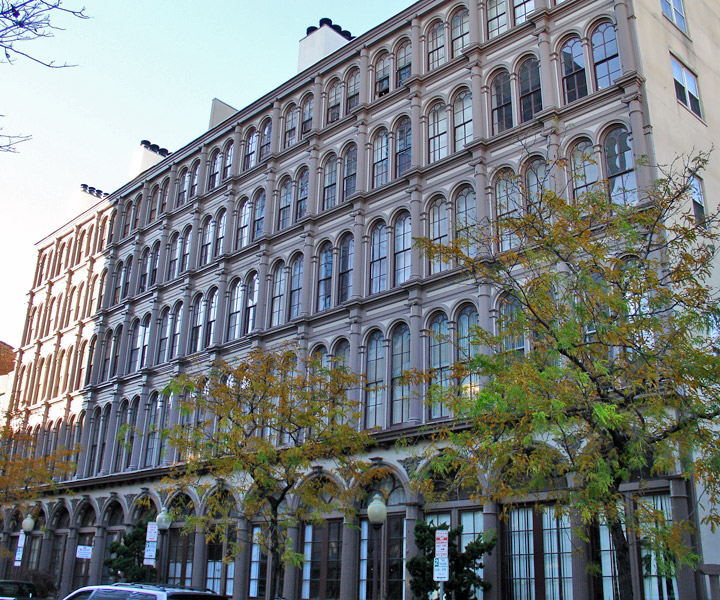

Old Town

residential buildings in the Old City Cultural District
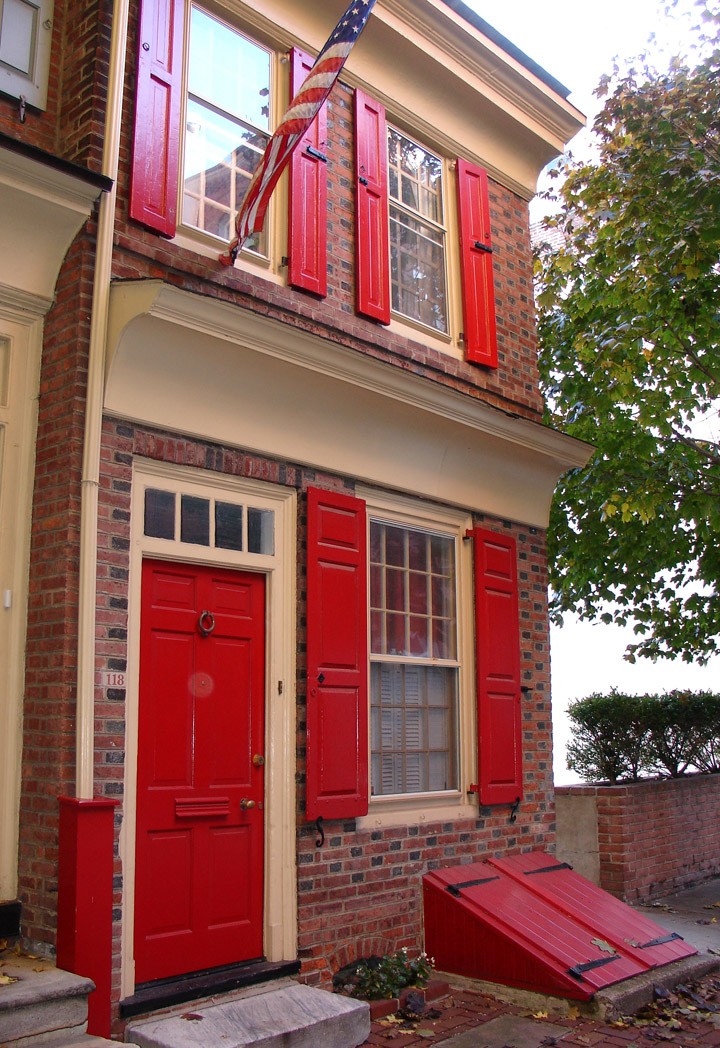
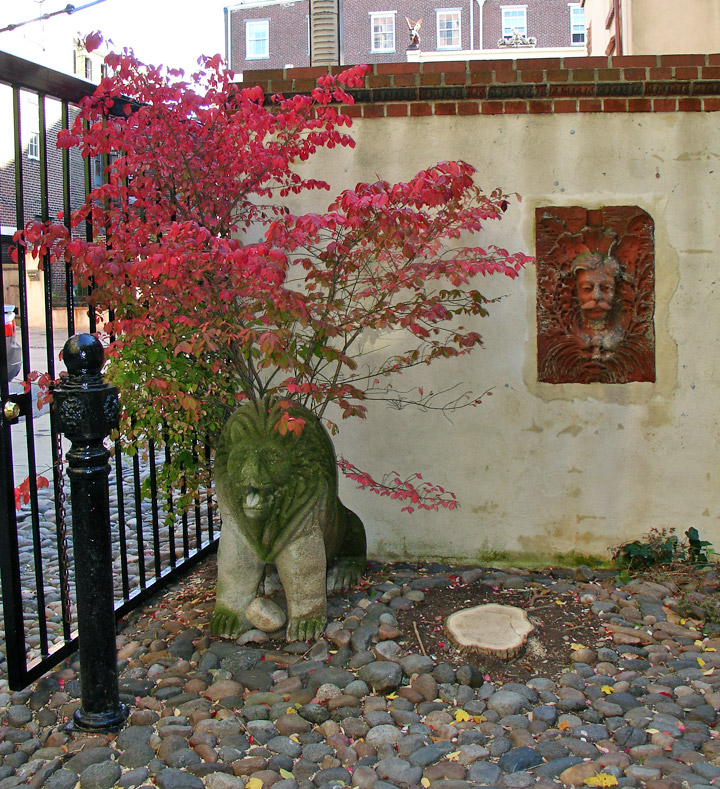
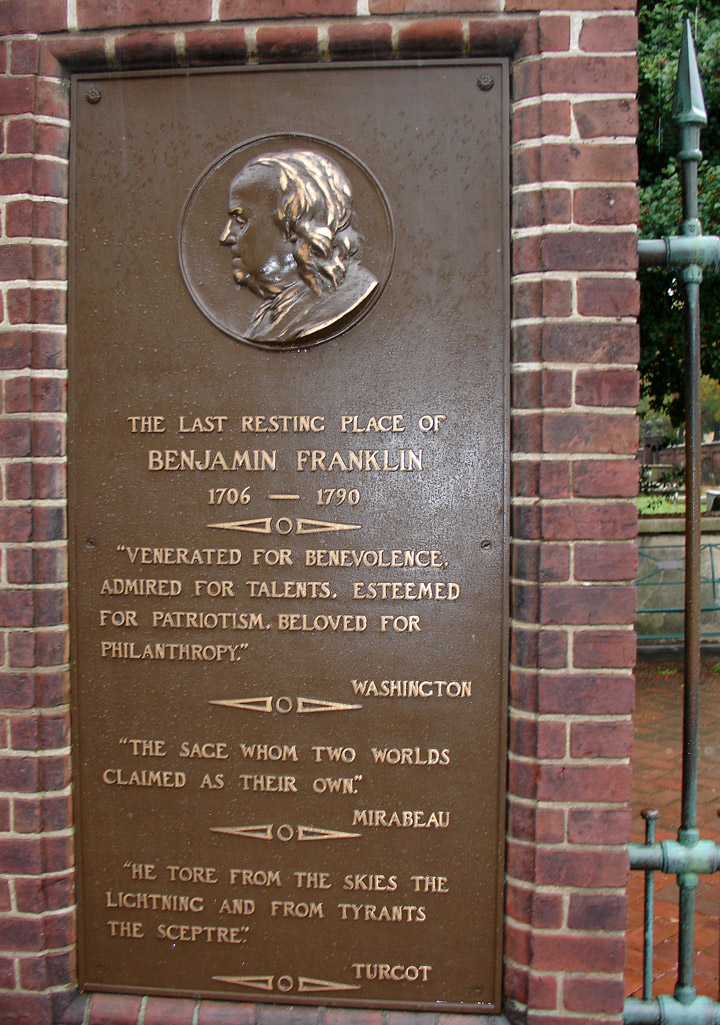
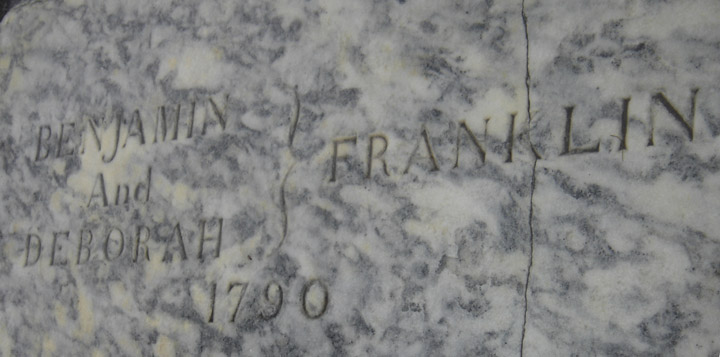
Ben Franklin's grave
Just opposite the Mint is Christ Church Burial Ground. Here Benjamin and Deborah Franklin's graves can be seen from the street through the grating. At Franklin's death some 20,000 Philadelphians followed his cortege to his grave here, as his death in 1790 severed the tie to Colonial Philadelphia. William Smith, Provost of the University of Pennsylvania and his old enemy, gave the eulogy in Christ Church, and the Comte de Mirabeau did the same before the French National Assembly in Paris. Franklin was as well loved by the French as by the Americans and as honored by them, too.
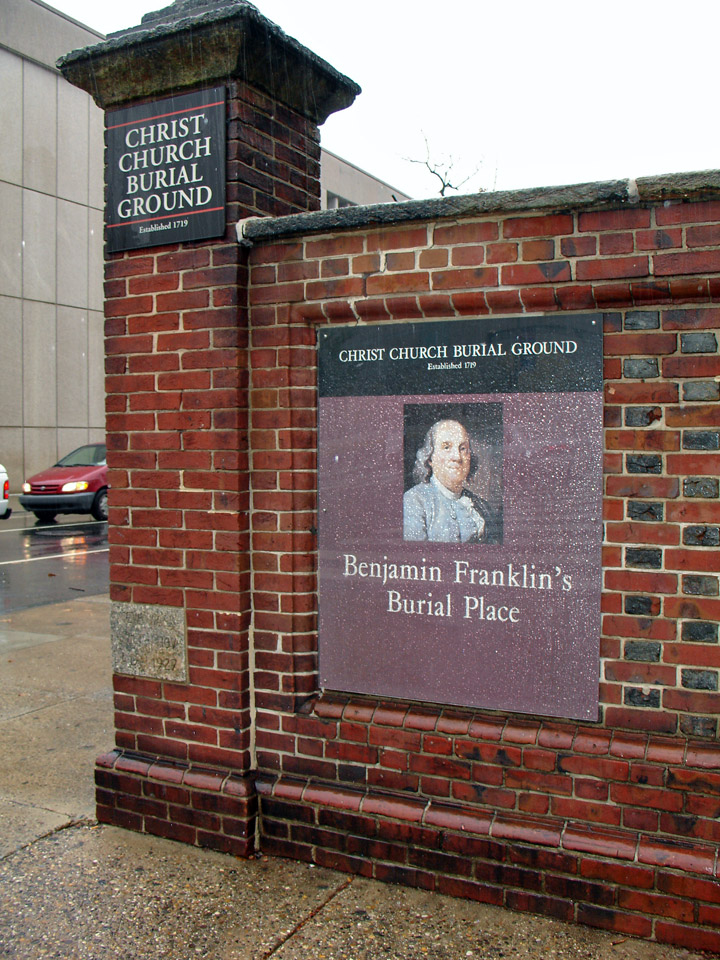
Also buried here are Benjamin Rush (1745-1813), the Father of American Medicine
who was also a Declaration signer and Philip Syng Physick (1768-1837), Father of
American Surgery. Three other Signers lie here: George Ross, Joseph Hewes, and
Francis Hopkinson (1737-91) — a composer who also designed flags and currency.
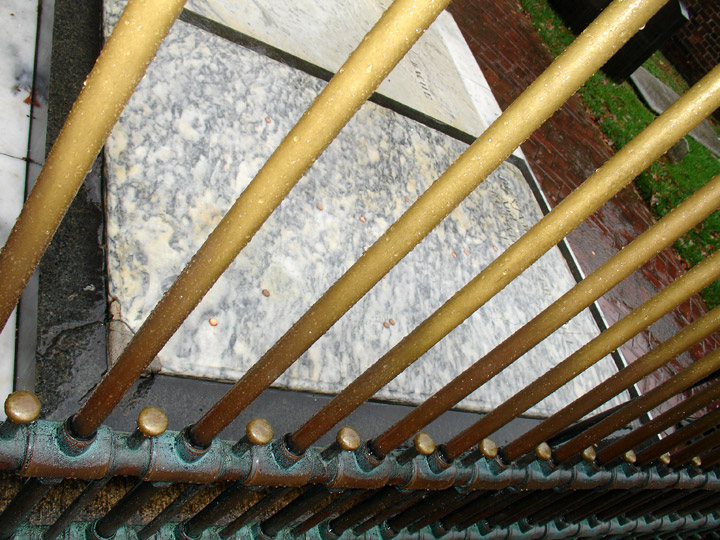
Benjamin Franklin's grave
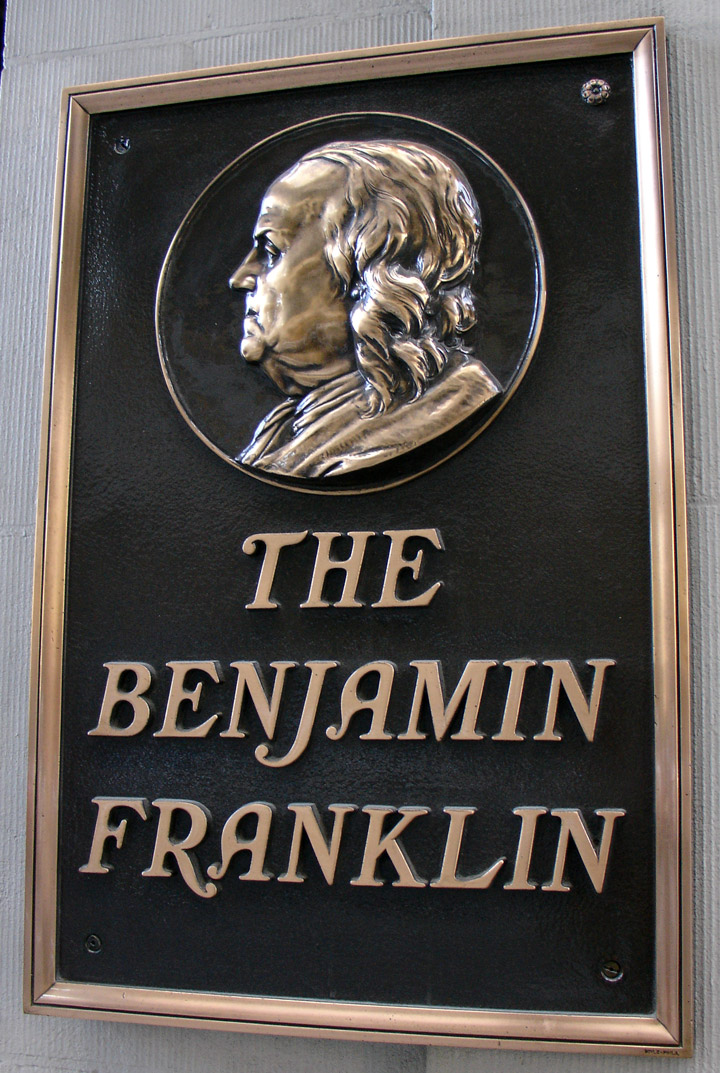
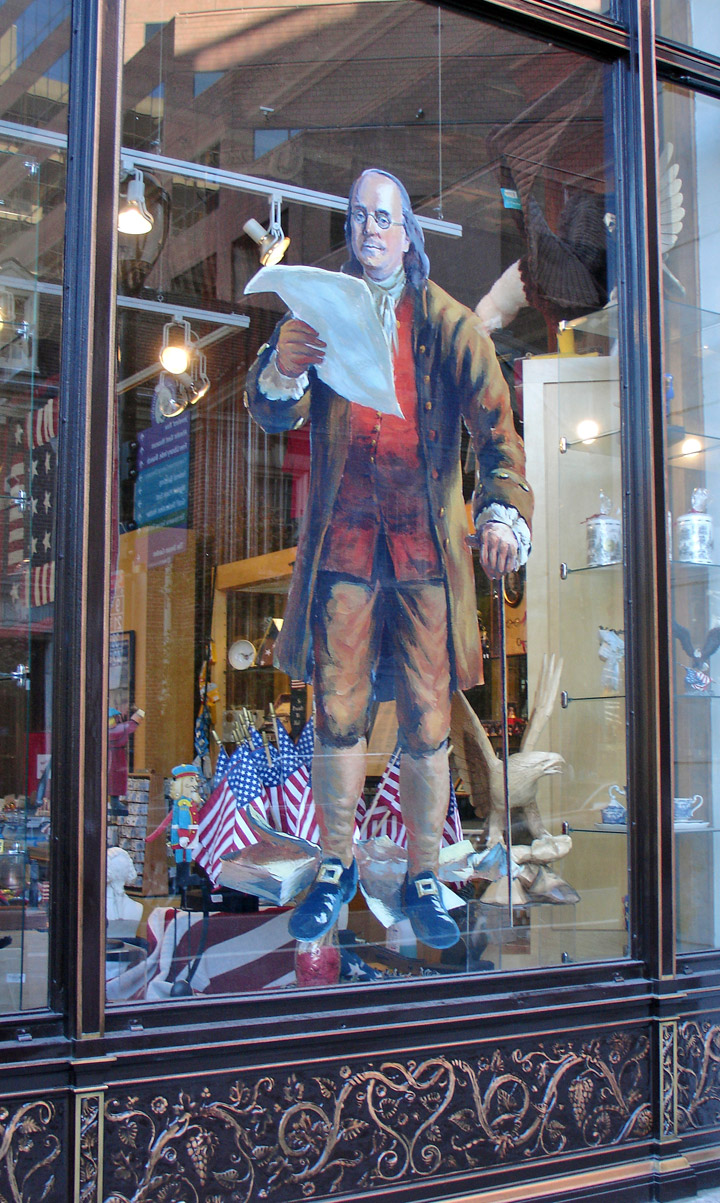
a respected citizen

Benjamin Franklin as a printer
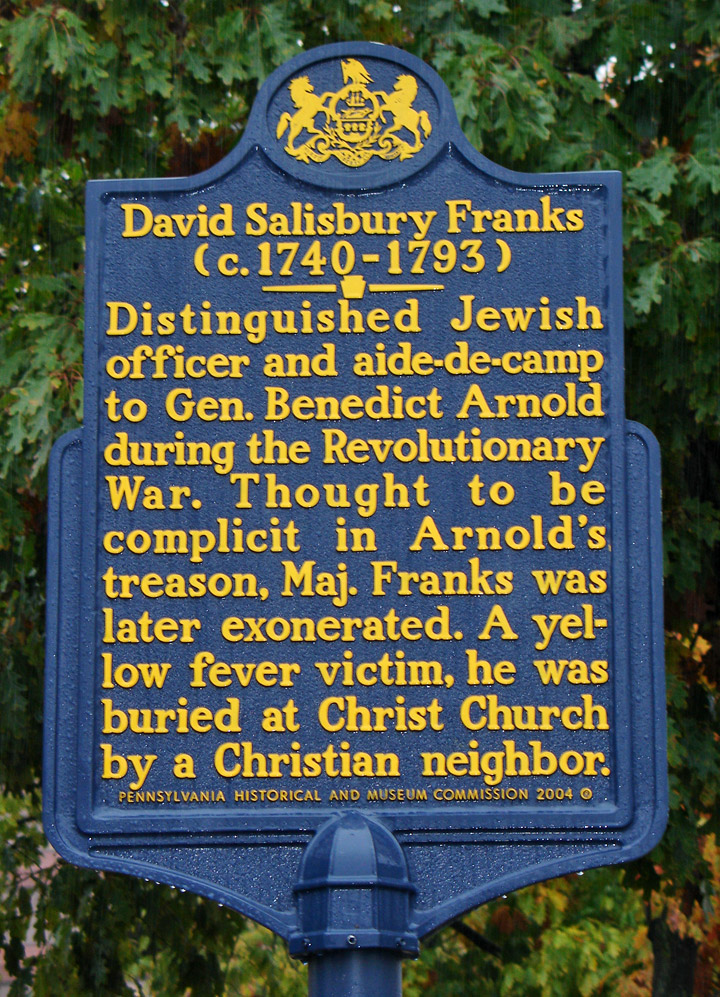
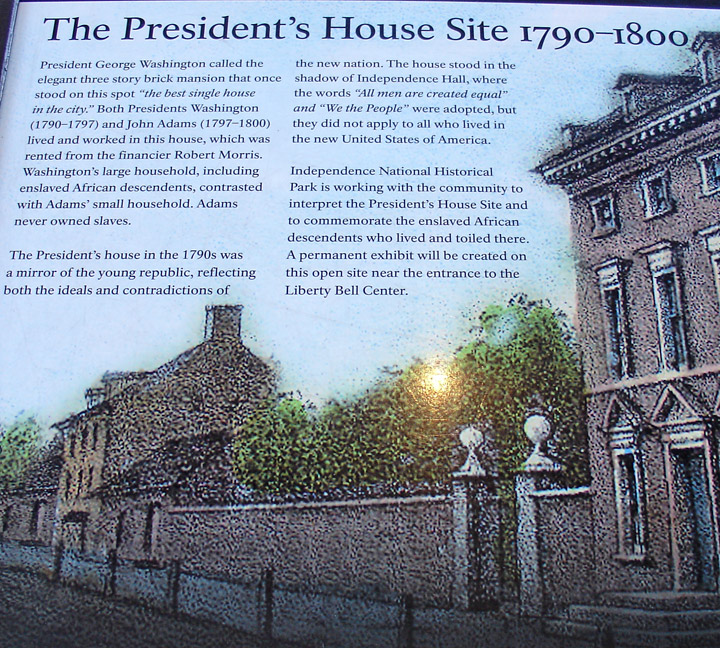
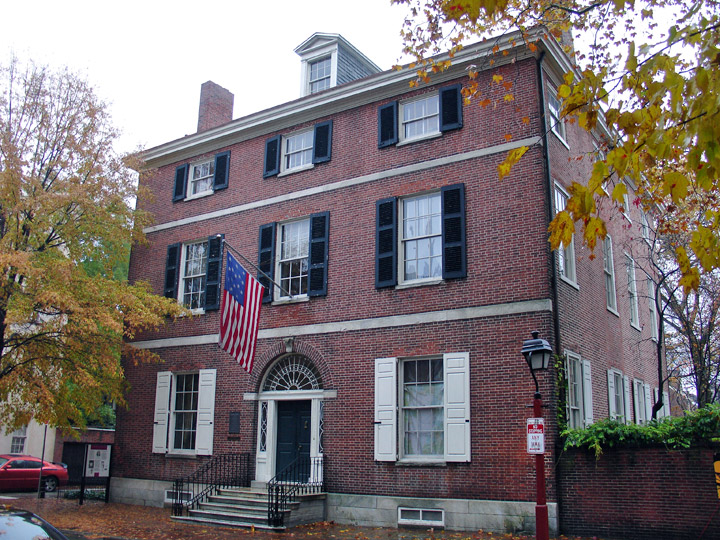
Physick's House
On 4th Street is one of the most magnificent houses in America. It is the only free-standing house in Society Hill and a superb example of a Federal house restored with Federal furniture. From the moment one enters and hear the guide's friendly, "Welcome to Dr. Physick's House," we are spellbound. The house was built in 1786 by Henry Hill, the executor of Benjamin Franklin's will. It was purchased for Philip Syng Physick (1768-1837) by his sister in 1790. The good doctor lived in the house from 1815 until his death, and his descendants lived here until 1941. Napoleon's influence is everywhere, from the rugs to the swan motif in the wallpaper.

The Society of Cincinnatus, one of the oldest and most distinguished in the
United States, has its headquarters in the upstairs parlor. A room honoring Dr.
Physick and his many surgical inventions is also on the second floor. The final
stop is a bedroom, and here, besides the spectacular bed, are several fine
Chippendale pieces.
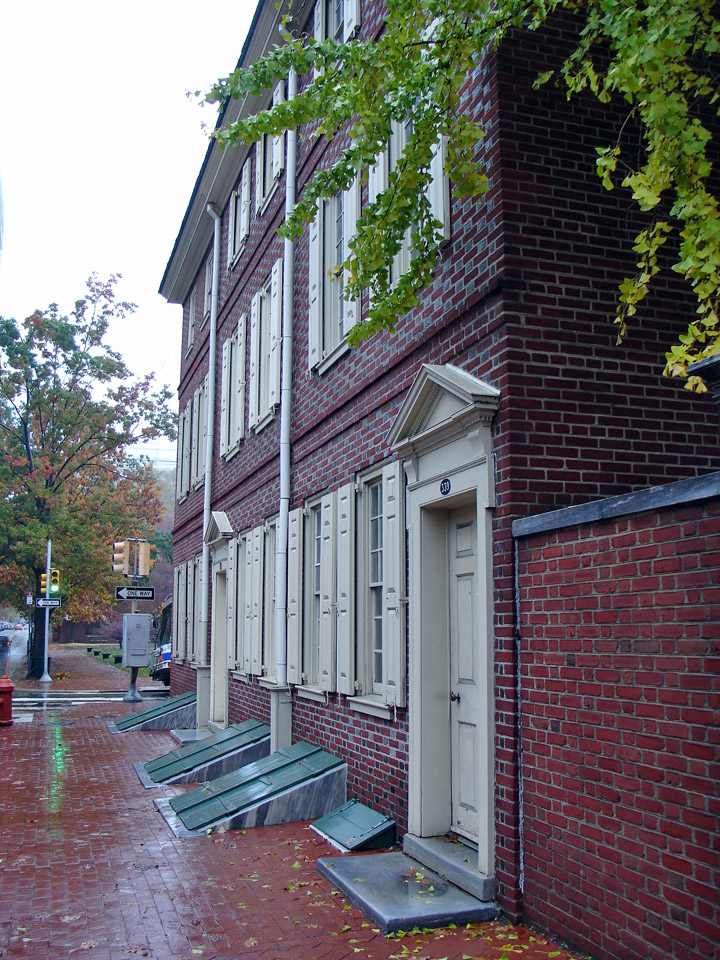
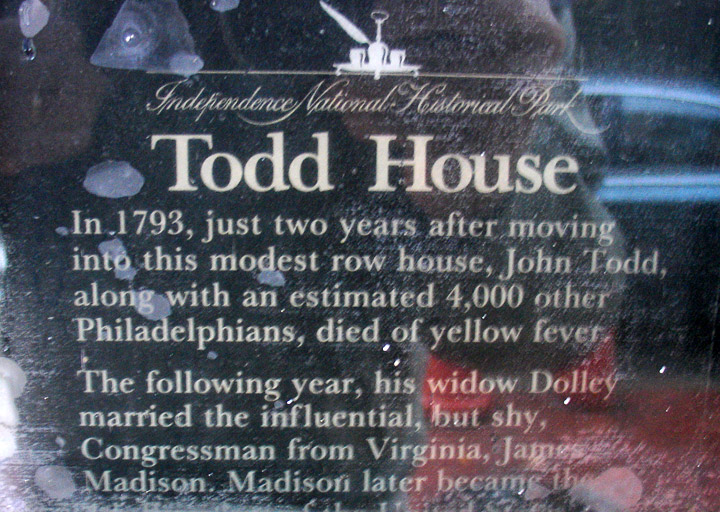
On the corner of 4th and Walnut Streets stands the Todd House, home of Dolley Madison. It was built in 1775 and occupied from 1791 to 1793 by John Todd, Jr., and his wife, Dolley Payne. After Todd's death in the yellow fever epidemic of 1793, she married James Madison, a young Virginia politician who was to become our fourth President. Stephen Moylan, the Revolutionary War general, lived here from 1796 to 1807.
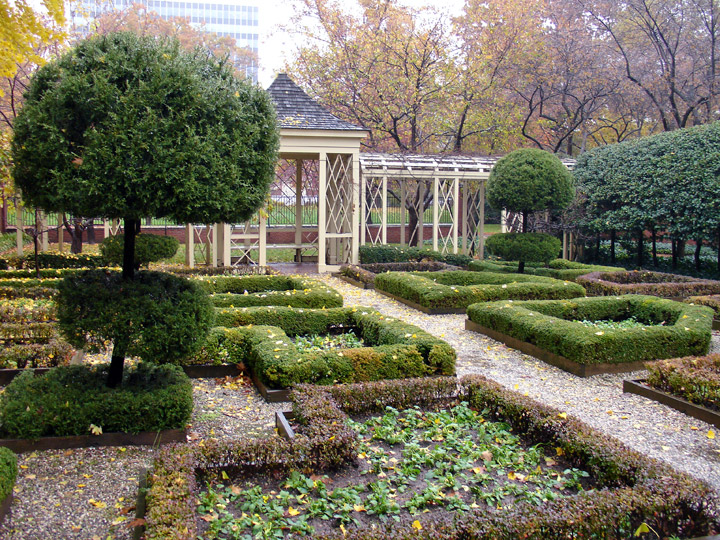
a Society Hill garden
The Philadelphia Contributionship
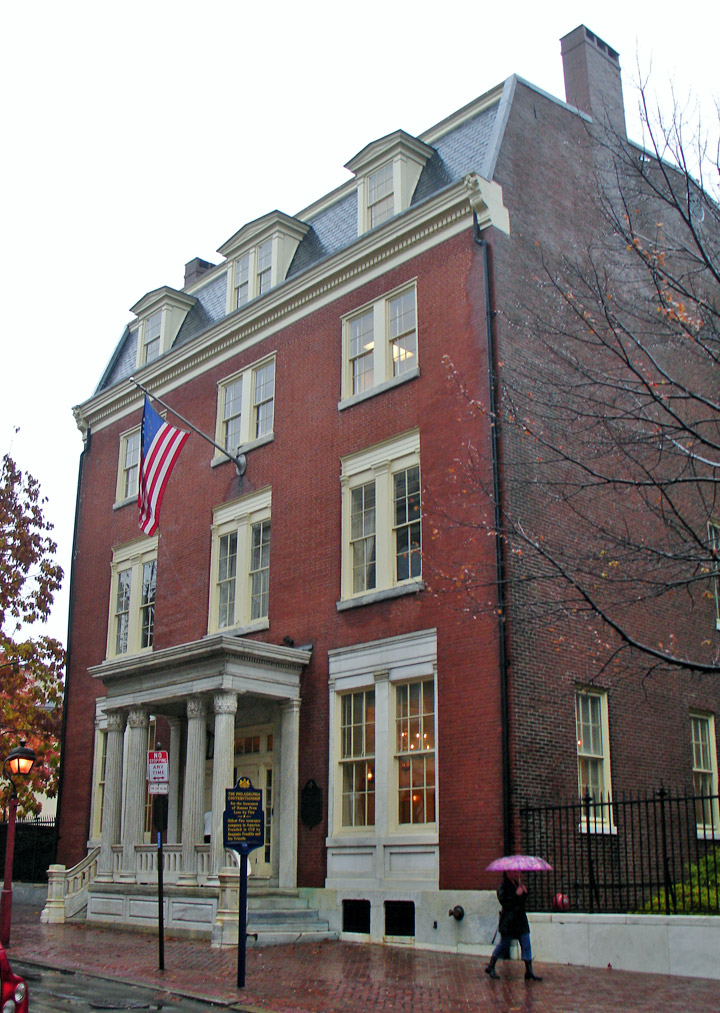
In reference to fighting fires, Ben Franklin noted, "an ounce of prevention is
worth a pound of cure."
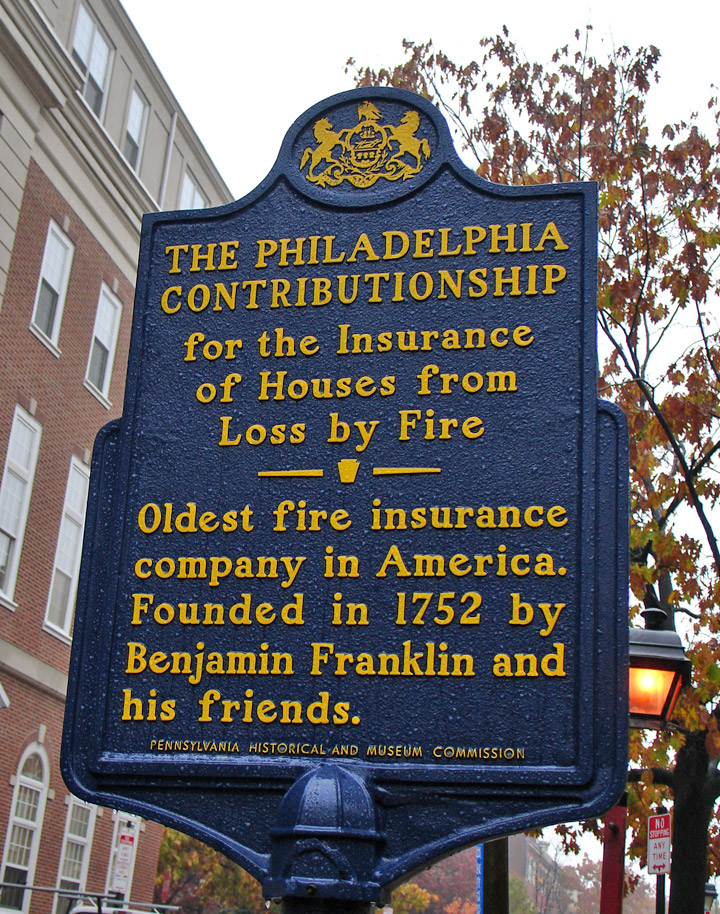
The Philadelphia Contributionship
In 1730, the most disastrous fire to rage in Philadelphia's history burst from the timbers of Fishbourn's wharf, a Delaware River structure. All the stores on the wharf burned and the fire spread across the street destroying three more homes. Damage ran into several thousand pounds. Benjamin Franklin commented in his Gazette that as there was no wind that evening, if people had been provided with good engines and firefighting instruments, the fire would likely have been contained.
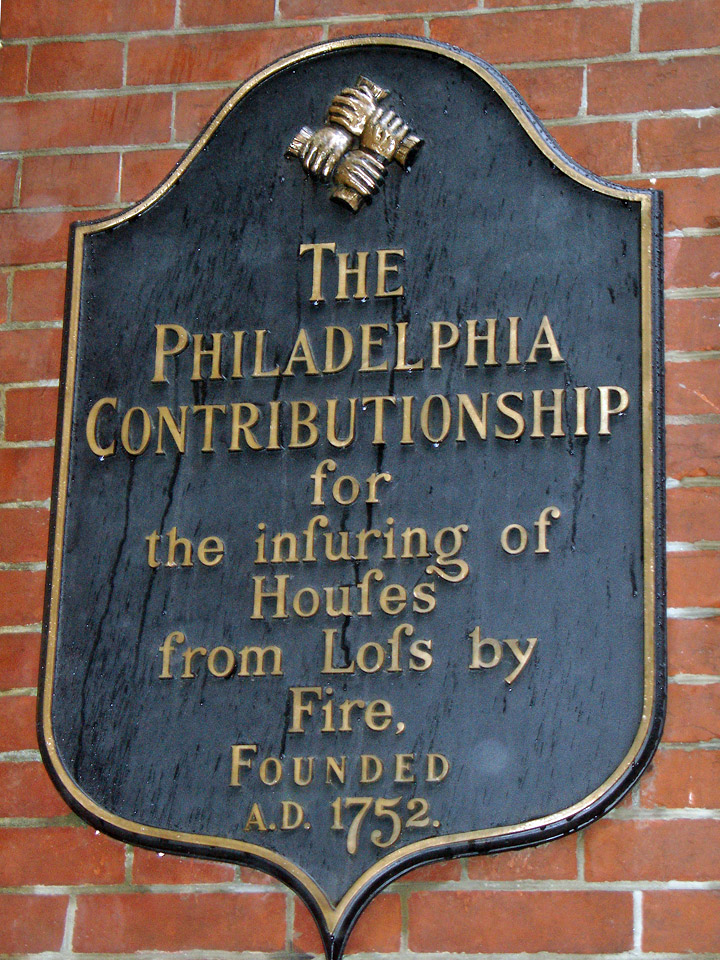
After that blaze, the Common Council of Philadelphia ordered fire equipment
imported from England. Leather buckets, fire hooks, ladders, and engines were
distributed at strategic points around town. A local resident even built his own
fire-engine which "threw the water much higher" than the London models.
It was to take 140 years, however, until the city of Philadelphia finally
created its own fire department in 1871. Yet, Philadelphia has never suffered a
conflagration on the scale of the 1666 Great Fire of London, nor of the fires in
Charleston in 1740 and Chicago in 1871. This was in large part due to the
efforts of — who else — Benjamin Franklin.
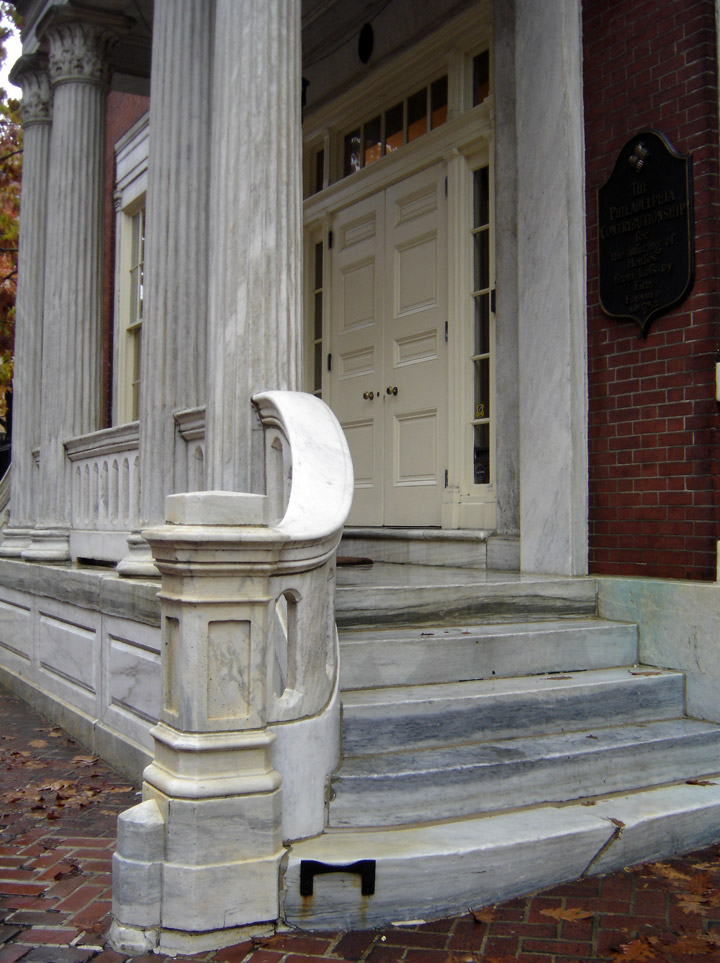
Contributionship entrance
Franklin, in his Gazette, gave
suggestions on fire safety: "In the first Place, as an Ounce of Prevention is
worth a Pound of Cure, I would advise 'em to take care how they suffer living
Coals in a full Shovel, to be carried out of one Room into another, or up or
down Stairs, unless in a Warmingpan shut; for Scraps of Fire may fall into
Chinks and make no Appearance until Midnight; when your Stairs being in Flames,
you may be forced, (as I once was) to leap out of your Windows, and hazard your
Necks to avoid being oven-roasted."
In a Gazette article of 1733 Franklin noted how fires were being fought. "Soon
after it [a fire] is seen and cry'd out, the Place is crowded by active Men of
different Ages, Professions and Titles who, as of one Mind and Rank, apply
themselves with all Vigilance and Resolution, according to their Abilities, to
the hard Work of conquering the increasing fire."
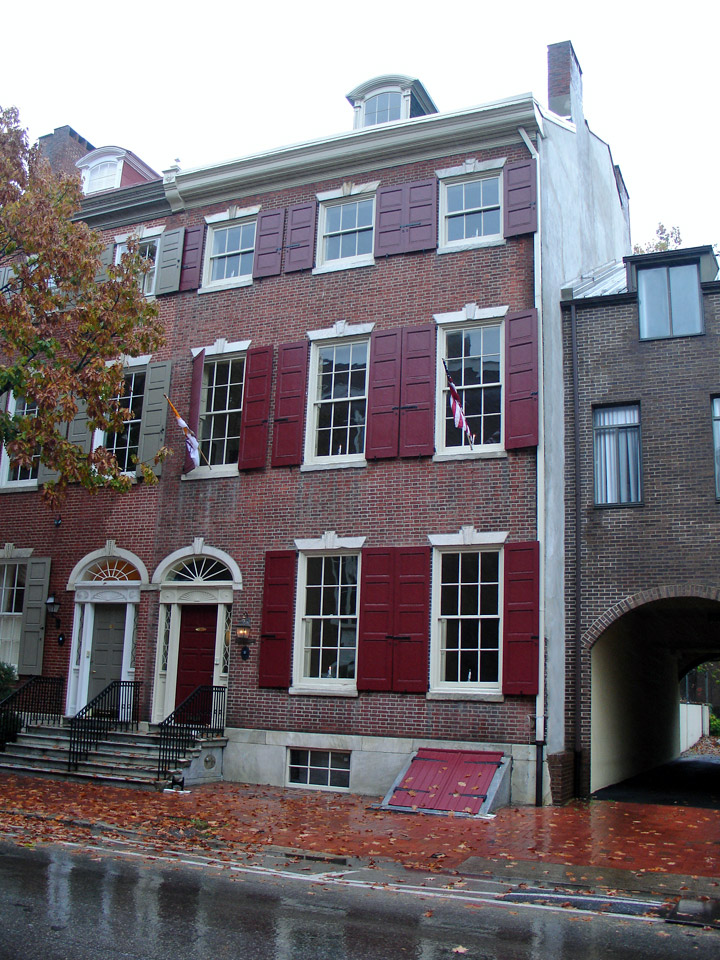
typical of an insured building
Good-will and amateur firefighters were not enough, though. Franklin suggested a
"Club or Society of active Men belonging to each Fire Engine; whose Business is
to attend all Fires with it whenever they happen."
Franklin's recommendations ultimately led in 1736 to the forming of
Philadelphia's first volunteer fire brigade, the Union Fire Company. So many men
wanted to join Franklin's Union Company that he suggested it would be more
beneficial to the salubrity of the city if they formed their own fire brigades.
In the next several years, Philadelphians witnessed the birth of the
Heart-in-Hand, the Britannia, the Fellowship, as well as several other fire
companies.
The logical next step was to form a fire insurance company. In 1751, Franklin
and members of his Union Fire Company met with firefighters from other brigades
for such a purpose. Over several meetings, insurance articles were discussed,
drawn up, and presented publicly. All interested in subscribing to the project
were told to sign a Deed of Settlement. The first to sign, Governor James
Hamilton, was the son of famed "Philadelphia lawyer" Andrew Hamilton (see
Independence Hall). Directly below Hamilton's signature are those of Benjamin
Franklin and Philip Syng. Initially, over 70 prominent Philadelphia citizens
became subscribers. On April 13, 1752, these men came together to elect a Board
of Directors and Treasurer, who met for the first time on May 11, 1752.
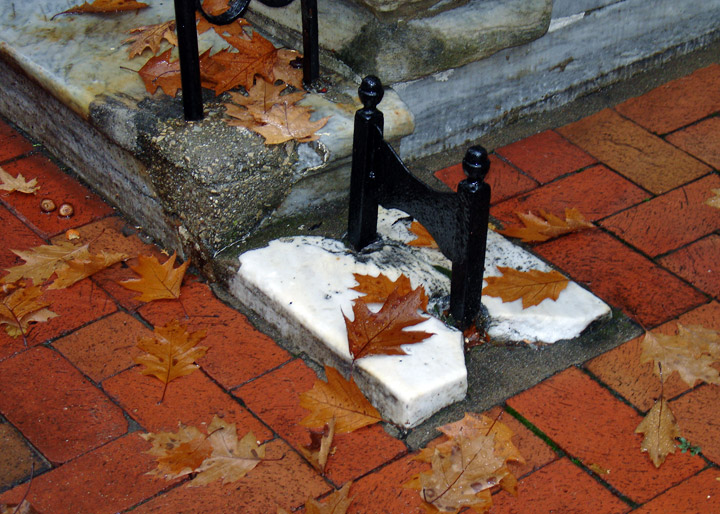
boot scraper
At that meeting it was affirmed that those subscribed had agreed to establish an
insurance company by the name of The Philadelphia Contributionship for the
Insuring of Houses from Loss by Fire, and "to be and continue to be Contributors
unto and equal Sharers in the losses as well as the gains." A dozen Directors
were elected to the board. Franklin's name headed the list, followed by Philip
Syng.
Syng, yet another of those extraordinary early Philadelphians, was an eminent
silversmith and creator of the inkstand from which the Declaration of
Independence was signed. In addition to being a vestryman at Christ Church and a
member of the Philosophical Society, Syng found time to design the corporate
seal for The Contributionship. Policyholders were required to affix these metal
fire marks on their houses. Today, in Philadelphia, fire marks adorn many older
and newer houses like a boutonniere on a suit.
Several Quaker merchants served on the original Board as did Samuel Rhoads, the
Master Builder of Pennsylvania Hospital — the oldest continually insured
institution in the country. Rhoads became the firm's first Surveyor, assigned to
inspect buildings and determine if they were appropriate risks for The
Contributionship. Once the recommendations of the Surveyor were made, all
Directors voted on whether a property should be insured. All this occurred at a
monthly meeting, which continues to this day (there are 10 meetings each year,
and, of course, the directors have different duties now). The first group of
Directors, who came up for re-election yearly, decided to levy fines on
themselves in cases of absence or tardiness from these meetings. Money from
these fines accumulated and was earmarked for civic improvements. The earliest
fine money went into making and placing mile markers between Philadelphia and
Trenton. Today a weather-beaten mile marker can be seen in The
Contributionship's garden, a reminder of the firm's philanthropic past.
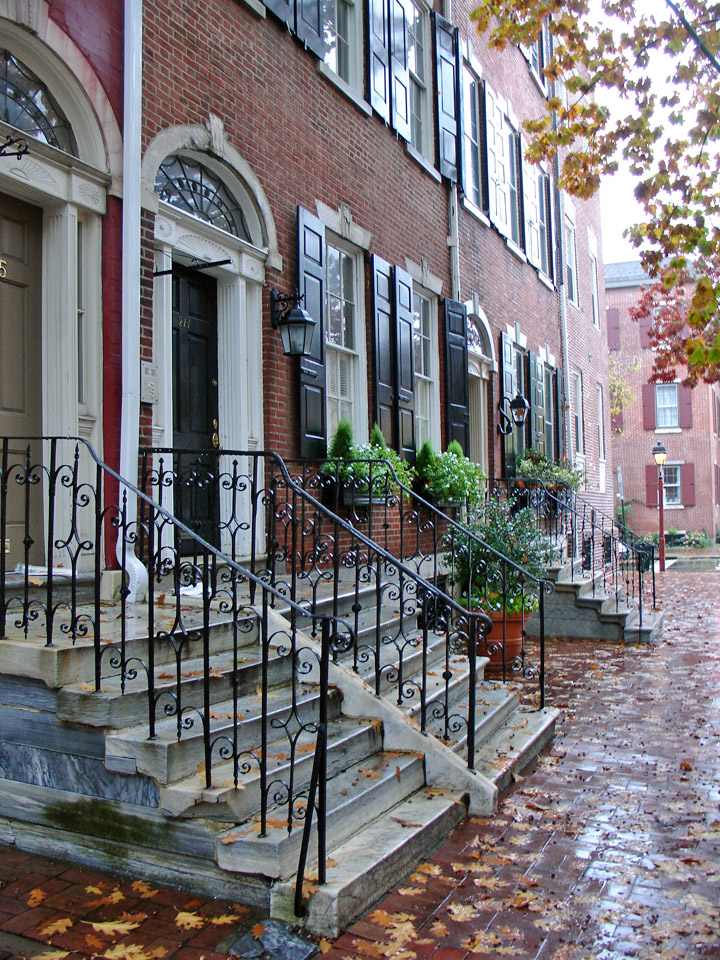
typical of insured buildings
The first policyholders took out policies for seven years. After expiration, the
premium money was returnable, subject to certain exceptions. Fire losses and
office expenses were paid with money taken from a proportionate contribution of
each policyholder.
Prudence coupled with providence have been hallmarks of The Contributionship.
Houses built not conforming to legal specifications were denied insurance. Mrs.
Lydia Biddle, for instance, was denied insurance because of an unlawful wooden
bakehouse adjoining her home. Early policyholders had to have a trap door to the
roof as a way of fighting roof and chimney fires. During the British occupation
of Philadelphia in 1777, a chimney sweep hired by the firm was sent around to
occupied houses to maintain fireplaces. The lightning rod, invented by Director
Ben Franklin, also helped to deter fires. Houses with trees in front of them
were not insured because early hoses could not maneuver around them (this gave
rise to a competitive company, the Mutual Assurance Company, which was better
known as the Green Tree, which existed until 1997).

High-fire-risk businesses, such as apothecary shops and breweries, were either
not given insurance or insured at significantly higher rates. Later, when
skyscrapers were being built, the firm refused to insure them — and to this day,
still don't. However, they do insure high-rise condominiums providing there is
adequate firefighting equipment that can reach the insured space. Their judgment
proved sound when the earliest Philadelphia skyscraper, the Jayne Building,
housing pharmaceutical supplies, had a crippling fire which destroyed its top
floors.
The Contributionship was fortunate in 1752, its first year, in that 143 policies
were written and not one fire was recorded. In 1753, a house on Water Street
became the first insured property to burn. Damage was great, but Franklin was
happy to report in the Gazette that damages were to be immediately repaired
without cost to the owner. Cost for repair totaled 154 pounds, nearly a third of
the Society's assets. Each member had five shillings threepence per pound of
deposit deducted to pay for the fire.
Over time The Contributionship's assets grew and they invested their money in
various ways. They wrote mortgages and invested in stocks and bonds. They
donated money to the volunteer fire companies who responded to structures
insured by The Contributionship. Though volunteer fire brigades responded to all
fires, they had more compelling reason to fight fires at buildings bearing The
Contributionship's hand-in-hand fire mark. These fire marks served several
functions. They indicated to fire companies that The Contributionship would
reward them for a job well done. Often, firefighters were members of The
Contributionship. The less damage to a building, the less deducted from their
own premiums. However, if a house was uninsured, the fire would be put out
regardless, despite what some modern historians and interpreters may claim. In
any case, fire brigades would usually bill the uninsured householder or an
insurance company with properties nearby to seek payment for their fine work in
battling the blaze.
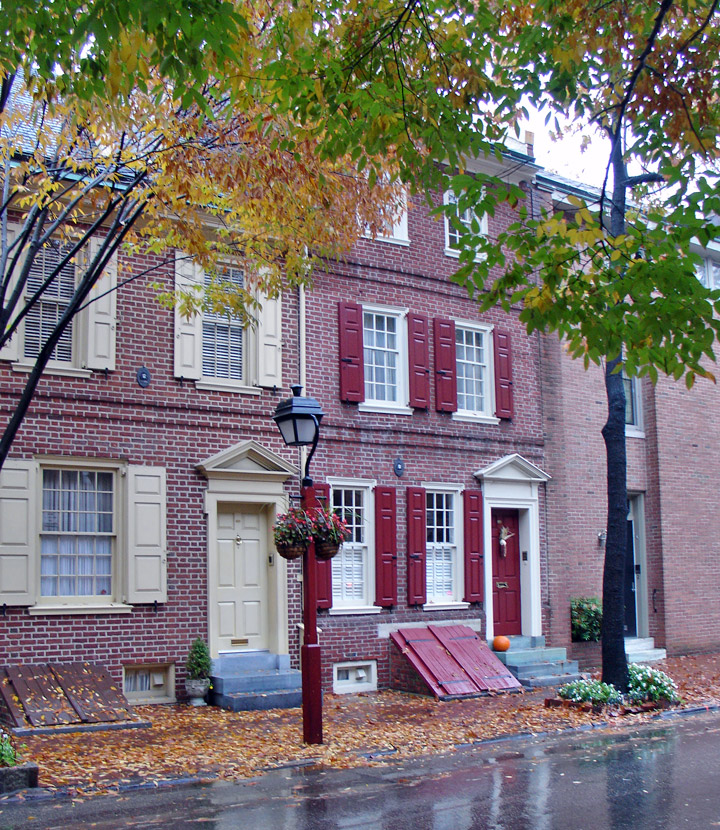
Philadelphians were keenly aware that the growing city's economic well-being
rested in the well-being of its citizenry. Allowing buildings to burn, perhaps
spreading into larger fires, made no sense. Philadelphia understood even then
the interconnectivity of its infrastructure and its economic health. When one
citizen suffered, all suffered.
THE MUSEUM
This building was erected in 1836 as home to The Contributionship, which
previously operated out of various houses and taverns. Today, the building is
used as their headquarters and contains a small but compelling museum presenting
a fascinating collection of memorabilia. There are fire marks, firemen's hats,
miniature engines, lanterns, and other accoutrements. A silver "speaking
trumpet" once used to tantara orders at confused fire sites is among the more
interesting artifacts because of its rarity. A fiery eagle clutching a
hand-in-hand fire mark and an American flag carved by Collins West catches the
visitor's eye. Fascinating, too, is a survey of Carpenters' Hall made in 1773.
You will also find surveys for the homes of John Penn (William Penn's son) and
Benjamin Franklin.
The second floor, which is open to the public by appointment only (see below),
is spectacularly elegant. The board room and the adjoining dining room are
lighted by superb crystal chandeliers. A colossal and beautiful walnut table
designed by Gottlieb Vollner dominates the room. Similarly stunning are the
chairs which surround the table — they were crafted by William Sanderson from
bird's-eye maple. Screens on latches graced the backs of the chairs nearest the
room's marble fireplace — they were designed to channel hot air around the
circular table so all Directors would be warm, but those closest to the fire
would not become rump roast. Today, only the latches remain.
A seating plan on the wall names the holders of the twelve Directors' seats
since The Contributionship's inception. Across the hall is a room which might be
called a double parlor in which the company holds its meetings. The grand table
designed by William Russell in 1892 is noteworthy. This space formerly housed
the treasurer's family's two bedrooms. Note the especially fine marble
fireplaces and gilt mirrors. Crystal candelabra and cachepots enhance the scene.
Fine portraits of past Directors stare back at us. Their conservative
countenances joined with the timeless strength of the room evince a strong
company nearly 250 years old, confident in its future.
While on the second floor the visitor can play a "Where's Waldo" game looking
for the hand-in-hand fire marks instead of Waldo. They are to be seen
everywhere, from fireplaces to sideboard — there are at least a dozen. The
sideboard was designed by Michael Deginther.
In addition to supplying the insurance needs of Philadelphians for nearly 250
years, The Contributionship has of late provided another valuable service.
Society Hill, the neighborhood of which The Contributionship is a part, has over
the last 40 years been transformed like the proverbial phoenix. Once, one of the
city's most delapidated areas, the neighborhood now contains more than 600
renovated houses and more 18th-century architecture than anywhere else in the
entire country. The Philadelphia Redevelopment Authority acquired many
deteriorated properties in the neighborhood and sold them to private individuals
with the agreement that the houses would be restored. As many of these houses
looked nothing like they did originally, some owners had to use past
Contributionship insurance surveys and records to aid them in recreating floor
plans and engineering features of these properties.
Many of the buildings you will visit are now, or have once been, insured by The
Contributionship. They include Pennsylvania Hospital, Christ Church, Old Pine
Street Church, the Powel House, Carpenters' Hall, Society Hill Synagogue (when
it was the Spruce Street Baptist Church), and, naturally, Benjamin Franklin's
1766 house on Market Street. Any virtual visitors with an interest in insurance
or firefighting are urged to read Nicholas B. Wainwright's A Philadelphia Story
— The Philadelphia Contributionship for the Insurance of Houses from Loss by
Fire, from which much information on this page was found.
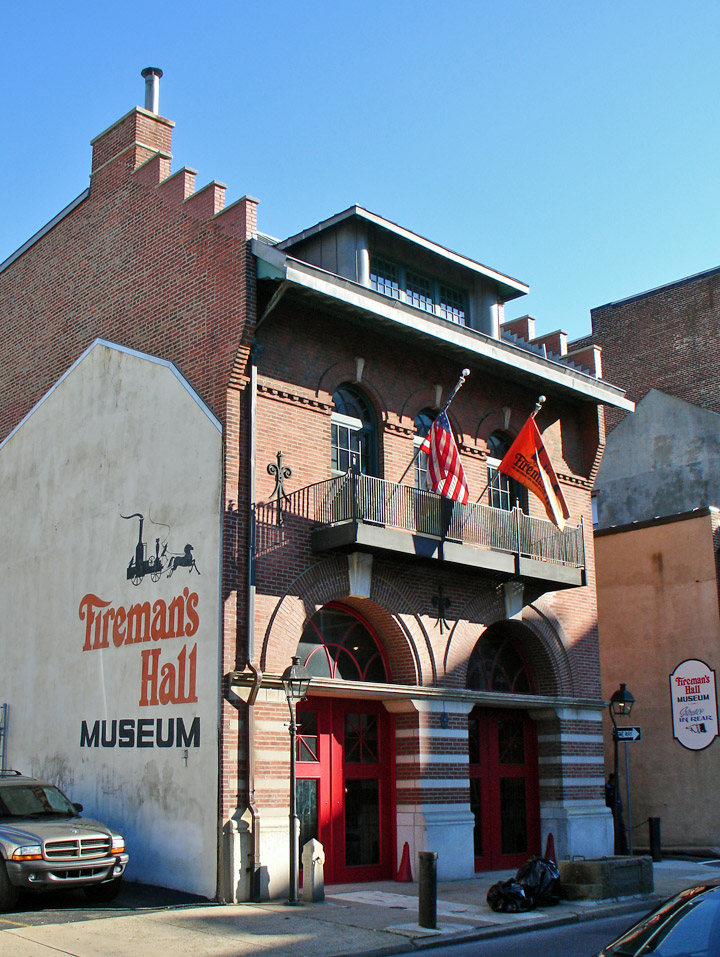
Fireman's Hall Museum
Return to 2nd, and turn right a few steps to visit the Fireman's Hall Museum.
Benjamin Franklin, who organized the first fire department — the Union Fire
Company on December 7, 1736 — would be proud indeed of this unique museum, for
there is nothing connected with fire departments, fire fighting and firemen that
is not here. There are fire engines from 1700s and 1800s, all equipped with
beautiful old brass fixtures. The first ones were hand-drawn, hand-operated by
the men themselves and before our modern ones, of course, there was the
horse-drawn fire engine.
Here are the leather buckets for water, miniature engines, nozzles, hoses,
firemarks from old houses, parade hats, early fire insurance policies, medals
and even a brass pole which goes from the third to the first floor, typical of
those that firemen slid down for generations. Perhaps the art of the fire engine
was carried to its apogee in the "Spider Hose Reel," made in 1804.
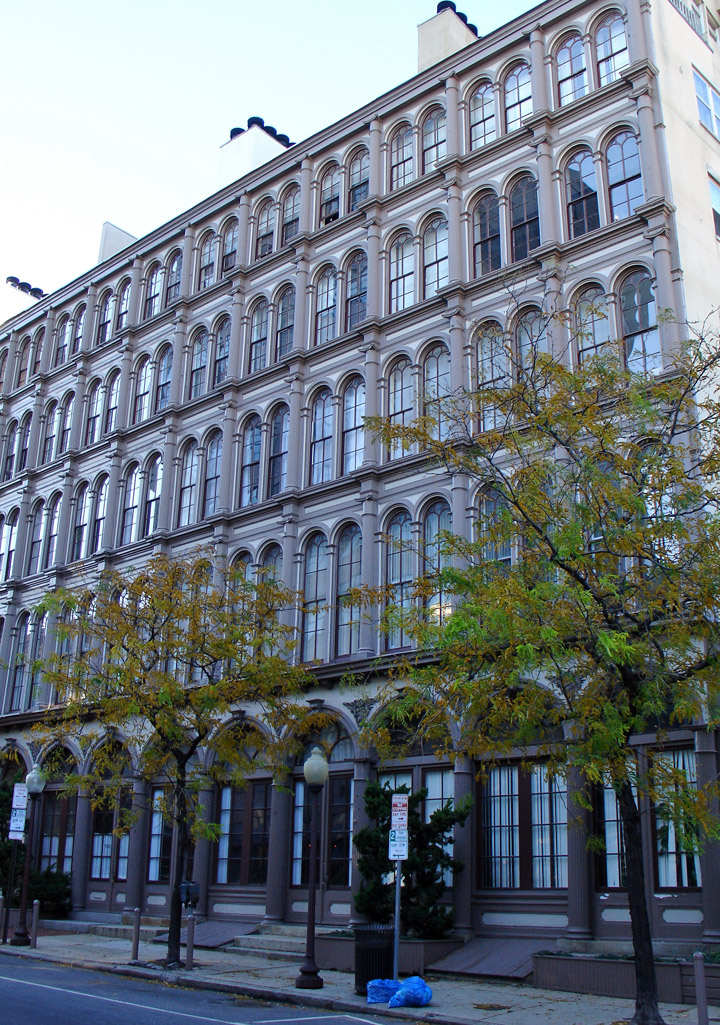
Iron-front building
Returning to 2nd and Arch Streets, turn left on Arch and walk again toward the river. On the northwest corner at 101-111 Arch, there is a series of fine iron-front buildings constructed between 1855 and 1857.
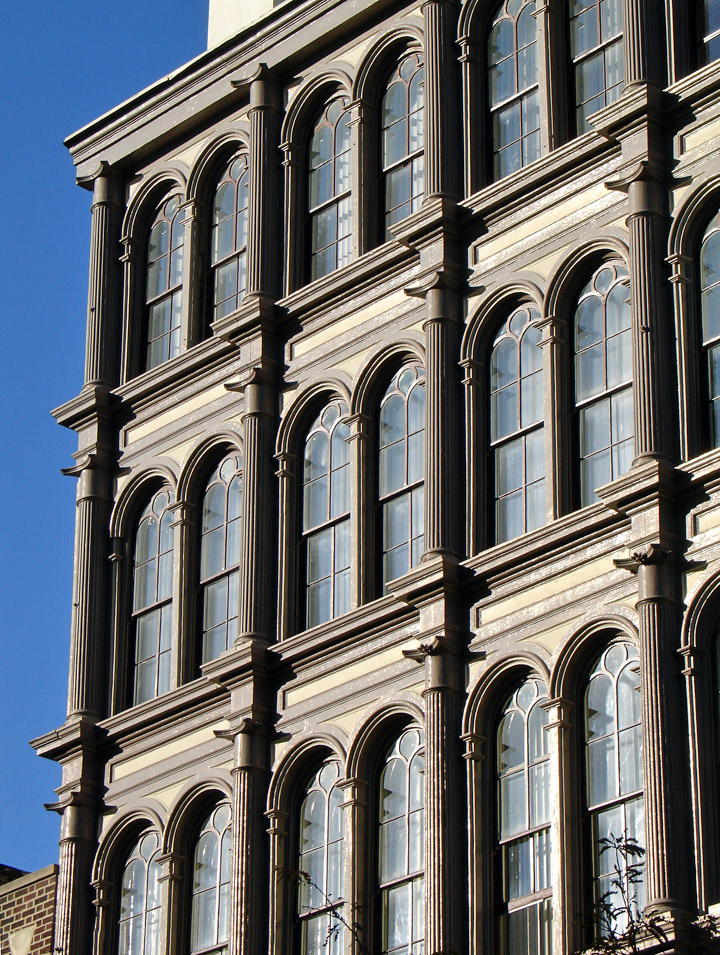
The group typifies the buildings the Victorians gave us, which today are appreciated for their beauty and functionalism. Warehouses, commercial buildings and lofts don't have the allure for the layman that grand town houses or even small, intimate ones have. Man likes to see the lares and penates of his ancestors — the antiques — in their proper surroundings. However, nothing reveals the character of a town or city like the buildings near its rivers and wharves. Here was the lifeblood of Philadelphia.
